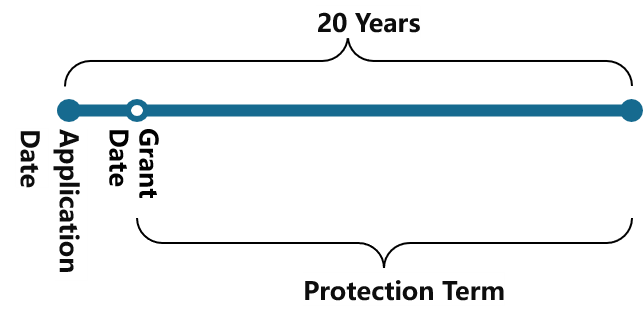On June 1, 2021, the fourth amendment to the Patent Law came into effect, formally establishing the patent term compensation system. This system is not unique to Chinese patent law; similar systems exist in the TPP Agreement, US patent law, and Korean patent law.
1. Why Compensate for the Protection Term?
Let’s look at the start and end points of the invention patent protection term:

It is evident that the end date of the patent protection term is fixed, 20 years from the application date. However, the start date is uncertain because the grant date is not fixed. If a patent is examined and granted quickly, the protection term is long; if the examination and grant are slow, the protection term is short, which can lead to significant unfairness.
For example:
- ZL200810081997.2—Online Transaction Processing System, application date: May 25, 2000, grant date: May 19, 2000, examination took over 19 years, protection term only 4 days.
- Worse is ZL200910117964.3—Recording Medium, application date: February 1, 1995, grant date: May 19, 2000, examination took over 25 years, the patent had expired 5 years before the grant, resulting in no protection term at all.
From a fairness perspective, it is essential to compensate for the shortened patent protection term caused by delays not attributable to the applicant. Additionally, certain types of products (currently limited to pharmaceuticals) require extensive testing and approval before market launch, often significantly reducing the effective patent protection term by the time they are sold. This diminishes the incentive for innovation, making term compensation for these products necessary.
2. Regulations on Patent Term Compensation
Patent Law Article 42, Paragraph 2: “Where a patent for invention is granted four years after the application date and three years after the request for substantive examination, the patent administrative department under the State Council shall, at the request of the patentee, compensate for the unreasonable delay in the authorization process, excluding delays caused by the applicant.”
Patent Law Article 42, Paragraph 3: “To compensate for the time occupied by the review and approval process for new drugs, the patent administrative department under the State Council shall, at the request of the patentee, grant term compensation for related invention patents of new drugs approved for marketing in China. The compensation term shall not exceed five years, and the total effective patent term after new drug approval shall not exceed fourteen years.”
From the above provisions, it is clear that China provides term compensation for unreasonable delays in examination and for the approval process for new drugs.
3. Term Compensation for Unreasonable Delays in Examination(PTA)
Invention patents granted four years after the application date and three years after the request for substantive examination can receive term compensation for unreasonable delays during the authorization process, excluding delays caused by the applicant. The draft Implementation Rules and Examination Guidelines provide further clarification on “reasonable delays” and “unreasonable delays caused by the applicant.”
Reasonable Delays:
- Suspension of procedures: For example, if a dispute over patent application rights arises, leading to mediation or litigation, resulting in suspension of examination.
- Preservation measures: For example, if a court orders preservation measures for patent application rights during litigation, resulting in delays.
- Administrative litigation procedures: For example, if the applicant appeals a review decision to the court, causing delays.
- Reexamination after amending application documents: If the applicant amends the application documents during reexamination, causing delays.
Unreasonable Delays Caused by the Applicant:
- Failure to respond to notices within specified deadlines: For example, failure to respond to examination opinions or make corrections on time.
- Request for delayed examination: If the applicant voluntarily requests a delayed examination.
- Invoking priority documents: If the applicant missed content in the application documents and invokes priority documents later.
- Delays caused by requests for rights restoration: Excluding delays proven to be caused by the patent office.
- Other situations: For example, if the international application enters China but no early processing is requested, causing delays.
Calculation of Compensation Days: Compensation days = Grant date – MAX(application date + 4 years, date of request for substantive examination + 3 years) – reasonable delay days – unreasonable delay days caused by the applicant.
For instance, if a PCT application in China had reasonable delays due to reexamination and suspension (806 days and 365 days) and unreasonable delays caused by the applicant (6 days), the compensation days would be calculated as: Compensation days = December 9, 2022 – MAX(September 16, 2015 + 4 years, December 5, 2015 + 3 years) – 806 days – 365 days – 6 days = 3 days.
|
Event |
Date |
|
PCT application filed |
December 8, 2013 |
|
Entered Chinese national phase |
September 16, 2015 |
|
Substantive examination request filed |
December 5, 2015 |
|
First Office Action issued |
April 10, 2018 |
|
Requested 2-month extension for response |
August 25, 2018 |
|
Submitted response to First Office Action |
August 31, 2018 |
|
Rejection notice |
February 1, 2019 |
|
Amended claims and filed request for reexamination |
March 22, 2019 |
|
Rejection overturned |
June 6, 2021 |
|
Second Office Action issued |
July 14, 2021 |
|
Suspension request due to ownership dispute |
September 7, 2021 |
|
Examination resumed |
September 8, 2022 |
|
Submitted response to Second Office Action |
September 24, 2022 |
|
Grant date |
December 9, 2022 |
4. Patent Term Extension (PTE) Due to New Drug Market Approval
1. Scope of Patent Term Extension for Pharmaceuticals
The Implementing Regulations of the Patent Law state that the term “invention patent related to new drugs” as referred to in Article 42, Paragraph 3 of the Patent Law includes patents for new drug products, manufacturing methods, and medical uses. This means that the scope of patent term extension (PTE) is not limited to the drug itself but also extends to patents on its use and manufacturing process, offering broader protection for innovative pharmaceutical companies.
It’s important to note that PTE does not apply to patents for veterinary drugs, pesticides, or medical devices, nor to utility model patents.
Regarding the commonly discussed term “new drug,” the Examination Guidelines clarify that it refers to innovative drugs and qualifying modified drugs approved by the National Medical Products Administration (NMPA).
For “qualifying modified new drugs,” the Examination Guidelines provide specific categories eligible for PTE:
- Type 2.1 chemical drugs, which are esters or salts of known active ingredients.
- Type 2.4 chemical drugs, which include new indications for known active ingredients.
- Type 2.2 preventive biological products, which are vaccines improved by modifying strains or virus strains.
- Type 2.2 therapeutic biological products, which add new indications.
- Type 2.3 traditional Chinese medicines, which have new functional claims.
2. Calculation Method for PTE
According to the new Patent Law and its implementing regulations, the calculation of the PTE for pharmaceuticals is based on the period from the patent application date to the date the new drug is approved for marketing in China, minus 5 years. The extension period cannot exceed 5 years, and the total effective patent term after the new drug is approved for marketing cannot exceed 14 years.
This means that if the time from the application date to the market approval date exceeds 6 years, the PTE process can be initiated. If, at the time of market approval, the remaining patent term is more than 14 years, PTE cannot be granted.
3. Scope of Protection During the PTE
The 2023 Implementing Regulations of the Patent Law stipulate that during the PTE, the scope of protection for the new drug-related invention patent is limited to the new drug and its approved indications. The rights and obligations of the patent holder during this period remain the same as before the extension.
The Examination Guidelines further clarify that the relevant technical solutions for the new drug should align with the structure, composition, and content approved by the NMPA, including the approved manufacturing process and indications. If the designated claims do not cover the approved technical solutions, PTE will not be granted. During the PTE period, the protection scope is confined to the marketed new drug and its approved indications.
4. Conditions for PTE
The 2023 Implementing Regulations specify that to request PTE for a new drug-related invention patent, the following conditions must be met and the request must be submitted to the State Intellectual Property Office (SIPO) within 3 months from the date the new drug is approved for marketing in China: (a) If multiple patents exist for the new drug, the patent holder can request PTE for only one of the patents. (b) If a single patent covers multiple new drugs, PTE can be requested for only one of the drugs. (c) The patent must be valid and not have previously received PTE for new drug-related inventions.
In summary, the conditions are: one patent, one drug, one PTE. Innovative pharmaceutical companies should strategically manage their patent portfolios in China, planning for situations where one patent covers multiple drugs or one drug involves multiple patents, to balance drug and patent protection.
5. Combining Two Types of Patent Term Extensions
The Examination Guidelines clarify whether it is possible to concurrently enjoy the PTE provided by Article 42, Paragraph 2 (due to unreasonable delays in examination) and Article 42, Paragraph 3 (due to new drug market approval):
- If a PTE request due to unreasonable delays has been filed but not yet decided, the examiner should wait for the decision on this request before determining the PTE period for the new drug.
- If no PTE request due to unreasonable delays has been filed and the 3-month period from the patent grant announcement has not expired, the examiner should wait for the PTE request period to expire before determining the PTE period for the new drug. However, if the patent holder explicitly waives the right to request PTE for unreasonable delays, this waiting is not necessary.
Thus, a patent holder can apply for and enjoy both types of PTE, provided the conditions are met. The PTEs are cumulative, meaning the extension periods can be added together.
6. Application Process for PTE
- Application Timing: Within three months from the patent grant announcement.
- Application Documents: “Request for Patent Term Extension and Pharmaceutical Patent Term Extension” plus supporting documents (if required).
- Submission Method: In-person or by mail to SIPO.
- Fees: Fees are not yet specified.
- Overall Process: The application process is relatively simple.
- Note: Only invention patents are eligible for PTE. Utility model patents and design patents do not qualify.
Conclusion
Patent term extension is crucial, and companies should carefully consider and utilize China’s PTA mechanism in product development, commercialization, patent strategy, and technology transactions.

